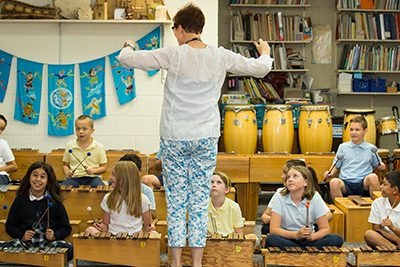September 21, 2017
 by Dr. Bill Hudson, Head of School
by Dr. Bill Hudson, Head of School
When I first heard that Lower School Music Teacher Mari Espeland was introducing her second graders to musician Lionel Hampton and to jazz, I had to see for myself. I thought I was going to simply observe a class, but I was drawn in as a participant, singing, dancing, and learning alongside the students. As a master teacher, Ms. Espeland wove together the basic musical foundation of rhythm and beat in jazz with a history lesson of race in America through the life of Lionel Hampton. I don’t know about the music education you received at this age, but I know this wasn’t part of mine.
I am continually amazed by the incredible music program we have at MPA. Students benefit from early and sustained music education that not only fosters a life-long appreciation for music, but engages students in making music, aesthetic appreciation, and creating beauty. Education in general, and most self-contained gifted and talented programs in particular, sacrifice time for the arts in favor of time for a narrow STEM-related curricula. I think that is a mistake and counter to good pedagogy. It also runs counter to the MPA mission.
There is ample research that connects with music education with academic achievement, language arts, science, and with 21st century skills.
- Researchers at the National Science Foundation have found that music is a key ingredient in the neurological roots of the creative process. It inspires higher brain functioning and improves cognitive outcomes.
- According to Assistant Professor Reyna Gordon at Vanderbilt University Medical Center, a correlation exists in children between good rhythm skills and a good grasp of grammar. Children who can detect rhythmic variations in music have an easier time putting sentences together.
- A recent study at Michigan State University compared every Nobel Prize-winning scientist from 1901 to 2005 with typical scientists of the same era and found that the Prize winners were dramatically more likely to be involved in the arts than the less accomplished scientists.
If you have a student in Middle School, be sure to ask them tonight about their visit today to the Ordway Center for the Performing Arts for a performance of the Tony and Grammy award-winning musical, “In the Heights.” In preparation for the performance, students learned about musical theater, Latino culture, immigration, and other related topics. We also hosted the show’s Music Director, Andrew Bourgoin, on Monday during a special Middle School assembly.
Andrew had the entire Middle School on its feet, dancing and clapping to the rhythm of the incredible combination of Latino and hip-hop music. He also shared what he has learned through his musical education. Empathy, compassion, how to listen, and understanding the perspectives of others are just a few of the skills he identified. He challenged students to think critically about the experience of Latino-Americans, with a foot in both cultures.
The scope, sequence and spiraling of music theory at MPA is often taken for granted. Yet the building blocks of rhythm, pitch, and harmony are blended carefully and thoughtfully with improvisation, movement and creative self-expression. Students’ involvement in music making fosters life skills such as leadership, self-discipline, problem-solving, cooperation, and community building.
In both instances, whether it was the second grade studying jazz or the Middle School delving into contemporary hip-hop, students were presented with a social justice lens through which to consider how both forms of music were born from a particular time and experience of multiculturalism. Together, we tackled serious topics. But we also sang. And danced. And laughed. This is whole child, joyful learning at its best!